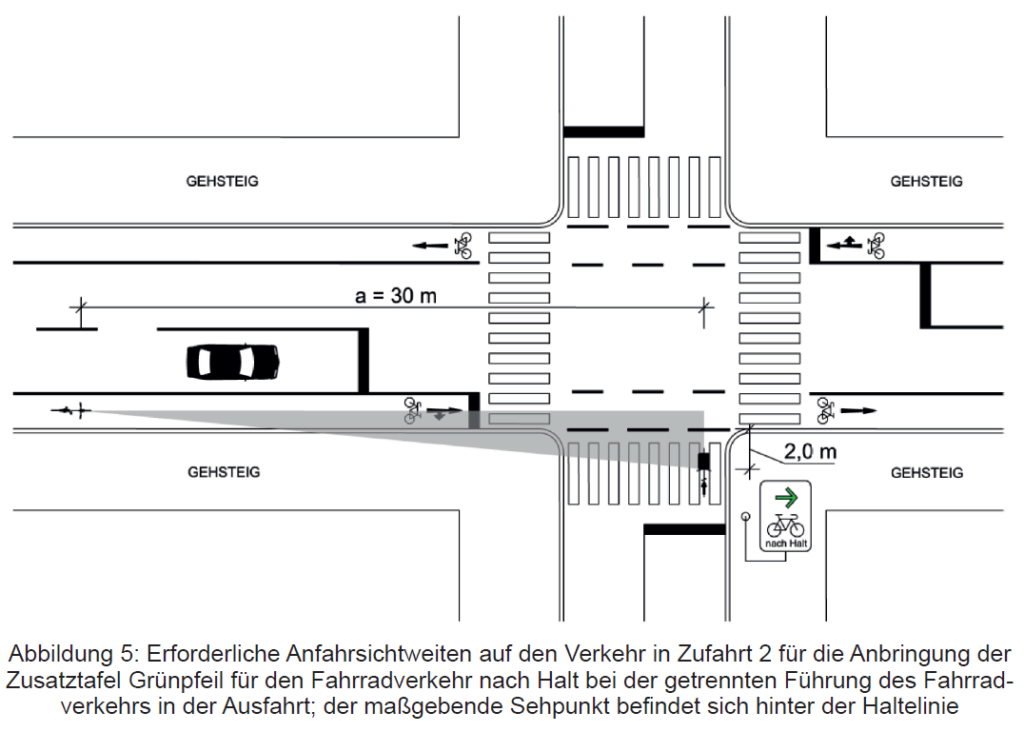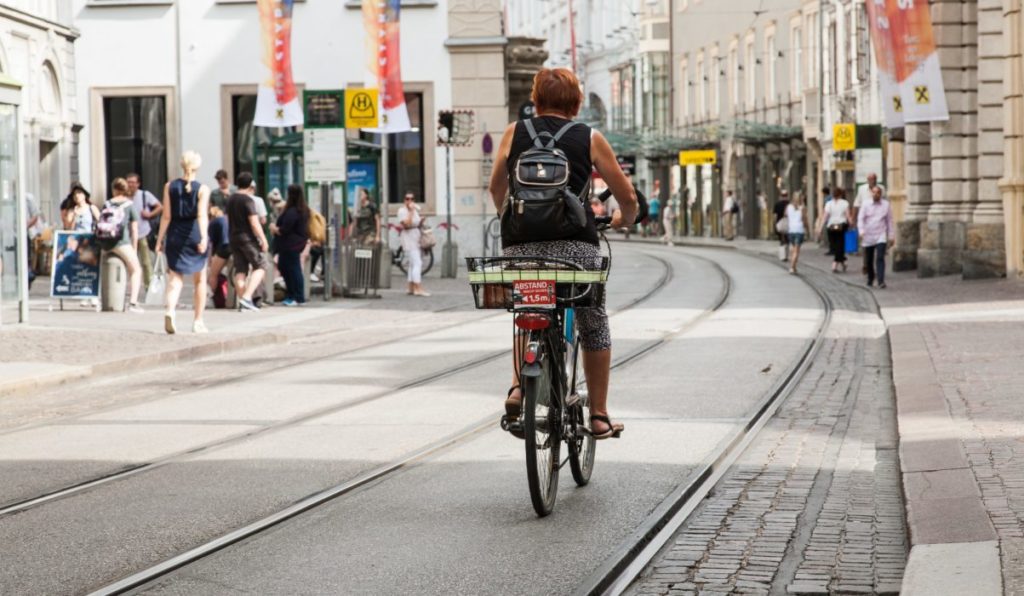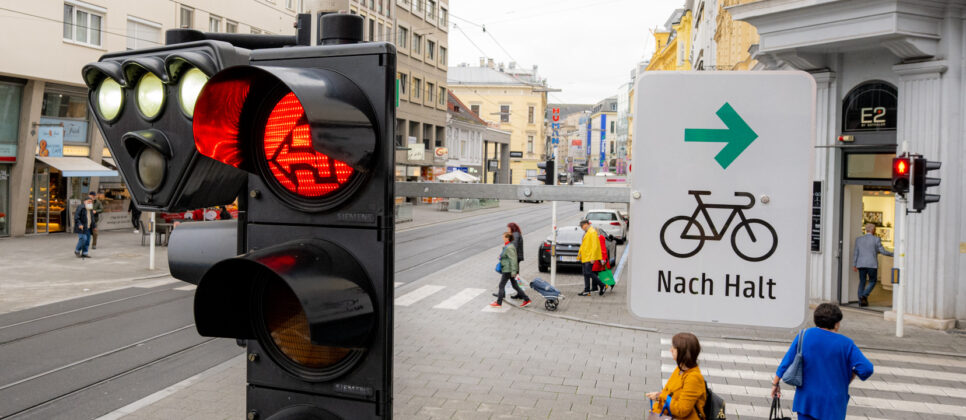Implementation of “right turn on red”: the Austrian criteria
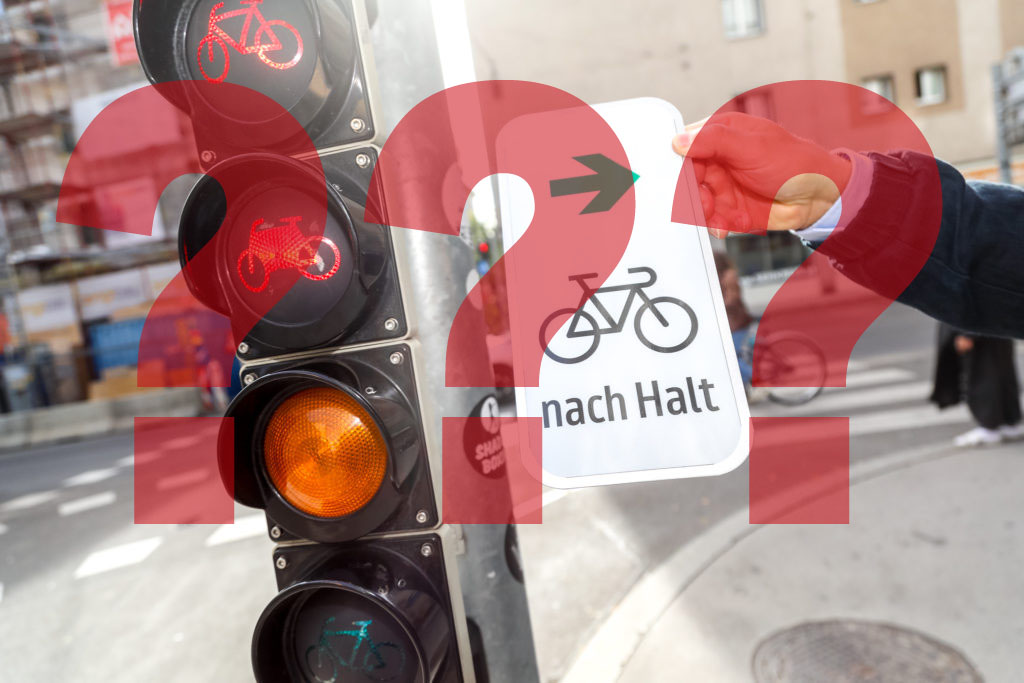
Since the change of the Austrian road code in 2022, it has been possible to allow cyclists to turn right or ride straight on at red lights at certain selected junctions. This is marked by additional signage with a green arrow. So far, 29 such signs have been implemented and Vienna has announced a ‘green arrow offensive’ of 150 planned junctions. But which conditions must be met to make their official implementation possible?
The research institute FSV (Straße-Schiene-Verkehr) has set out certain criteria as part of the RVS guidelines by which the additional signage can be installed in their “Paper Nr. 36 – Implementation Criteria for Additional Green-Arrow Cycle Signage”. The paper outlines that the new rule can be introduced in situations in which “the bicycle traffic merges with other streams of traffic at the point of exiting the junction at the nearest available bike or traffic lane but not in situations where these lanes cross each other”, this is equivalent to riding straight on at a T-junction and thus conforms to § 38 Paragraph 5a and 5b of the Austrian highway code.
The so-called “right turn on red” rule was introduced in France, Belgium, Denmark and Switzerland as well as the Netherlands some time ago. Austria adopted the German version of the rule in 2022 with a ‘stop-requirement’, similar to a stop sign. The Vienna University of Technology claims that right-on-red as a simple, cost-effective and safe measure to make traffic more bicycle-friendly increases the flow of bicycle traffic, reduces waiting times at traffic lights, encourages responsible cycling and minimises the time that cyclists spend in the blind-spots of drivers, greatly improving their safety. We already published an international comparison of this rule as well as an article on similar regulations in other countries.
The 9 exclusion criteria
If any one of the exclusion criteria laid out in the paper is met, the implementation of a “right turn on red” rule at the location in question is not possible. Below are short descriptions of the criteria and interesting insights into their development. The exact wording of the criteria can be found in “Paper 36” which can be downloaded for free from the RVS Shop (german). In the case that none of these criteria apply at the site in question and all other factors are carefully considered, nothing stands in the way of a “right turn on red” implementation.
1) Maximum 50 km/h
If the cycle traffic joins mixed traffic after entering the junction in question, the maximum speed of other vehicles may not exceed 50 km/h in order to reduce relative speeds between cyclists and motor traffic and improve safety.
2) Line of sight and distance to approaching traffic
If the traffic approaching the junction from the left of the turning cyclist is mixed, the minimum line of sight is dependent on the speed limit of the moving traffic. For example this is a minimum of 35 meters at 30 km/h, If, however, the approaching cycle traffic from the left is separated from motor vehicles either on a bike lane, a segregated cycle path or a mixed foot and cycle path, the minimum line of sight can be reduced to 30 meters, as shown in diagram 5, taken from the compilation of regulations.
Diagram 5: Line of sight distance to oncoming traffic required for the addition of “right turn on red, after stop” signage at a junction where cycle traffic and motor traffic are separated. The relevant point of measurement is behind the stop line.
3) Sight-lines to pedestrians
If it is not possible to see the entirety of the pedestrian infrastructure at a junction from the point of view of the halted cyclist, the addition of “right turn on red” is disallowed. This problem, however, can be overcome be advancing the stop line for cyclists to enable an adequate view of a pedestrian crossing.
4) View of traffic lights
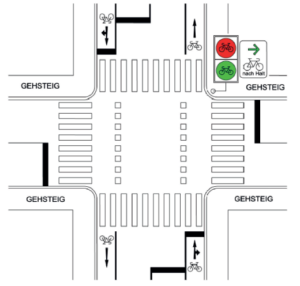 If the traffic lights governing the potentially right-turning cyclists are on the opposite side of the junction, they must be close enough for the additional sign to be easily read, otherwise implementation is not possible. Likewise, if there is a structurally separated bi-directional cycleway on the opposite side of the junction, “right turn on red” signage cannot be added. This is to avoid cyclists misunderstanding the instruction and crossing lanes of motorized traffic currently in a green light phase to turn right onto the bi-directional cycleway on the opposite side of the road.
If the traffic lights governing the potentially right-turning cyclists are on the opposite side of the junction, they must be close enough for the additional sign to be easily read, otherwise implementation is not possible. Likewise, if there is a structurally separated bi-directional cycleway on the opposite side of the junction, “right turn on red” signage cannot be added. This is to avoid cyclists misunderstanding the instruction and crossing lanes of motorized traffic currently in a green light phase to turn right onto the bi-directional cycleway on the opposite side of the road.
5) Distance from tram tracks
If the street into which cyclists turn has mixed traffic and tram tracks, the distance between the curb and the outermost track must exceed 1.5 meters. According to the FSV, if this width is too narrow, cyclists are at risk of getting caught in the tram tracks before completing their maneuver.
6) Weight of traffic
If the cycle traffic at the proposed junction is mixed with motorized traffic, the main road into which cyclists turn or from which cyclists leave, must have fewer than 50 HGV-like vehicles per hour, or a maximum of 500 per day. Otherwise, it is presumed that adequate lines of sight to pedestrians, passing distances and safe conditions for cyclists using the junction cannot be met.
7) Left-turn lane with dedicated traffic light phase
If the right-turning cycle traffic is mixed with motor traffic and the left-turning traffic from the opposite direction has its own traffic light phase, there is a high level of risk when these two streams of traffic meet due to the turning motor traffic coming from a potentially unexpected direction.
8) Vicinity of schools, hospitals and retirement homes
For the protection of more vulnerable road-users, “right turn on red” signage will not be positioned within 60 meters of the main entrances of schools, hospitals, retirement homes, homes for the blind and other similar buildings. Busy school routes will also be omitted from “right turn on red” infrastructure to ensure safety. The 60m radius around such buildings is taken from the RVS guidelines pertaining to school sorroundings.
9) High accident quota at common right-turn junctions
New “right turn on red” signage will not be implemented at junctions where there have already been high instances of cycling accidents caused by illegally turning right through a red light. Any new “right turn on red” signage would simply leagalise behavior which has proven to be dangerous at such locations and would therefore not be conducive to cyclists’ safety.
Other criteria from the guidelines
The paper mentions further criteria which are problematic for the safe operation of a “right turn on red” system in particular circumstances. These must be assessed case by case.
- Lane width less than 3m in mixed traffic in the approaching street. In order to optimize “right turn on red” for cyclists, these should approach the junction using either their own segregated cycle path or at least a dedicated cycle lane of adequate width.
- High weight of bicycle traffic in the approaching street without an advanced stop line. Cyclists required to wait at a traffic light before riding straight on could easily get in the way of those planning to turn right after stopping. This could be overcome with a larger area for cyclists in front of waiting traffic at a junction.
- High weight of cycle traffic passing the junction. This would leave too little time for cyclists to safely turn into the road from a junction.
- High weight of cycle traffic on bi-directional cycleways or shared-use paths, due to the conflict potential with other cyclists or with pedestrians approaching from the right.
- Too steep of a gradient in the road approaching the junction.
- Too steep of a gradient in the road the cyclists join when mixed traffic is present.
- High weight of motorized traffic in the road the cyclists join. In this case there may not be enough time between vehicles for cyclists to safely join the flow of traffic. This is, however, only a problem when the weight of traffic is consistently heavy for most of the day.
- High weight of pedestrian traffic crossing the road approaching the junction when they have a green pedestrian light.
The exclusion criteria and other criteria for cycling straight after stopping at T-junctions is, understandably, identical and can be read in full in the RVS guidelines of “Paper 36” in the RVS Shop here.
Background of the criteria
The criteria were developed in the “Urban Traffic” working group of the FSV in the committee “Non-Motorized Traffic,” led by the KfV (Austrian Road Safety Board) and including members of the Cycle Competence network such as Michael Skoric of con.sens mobility design, Roland Romano of Radlobby Austria, and Felix Beyer for Rosinak & Partner. The processing phase was accompanied by calculations at the Vienna University of Technology, which made important contributions to the definition of the criteria for lines of sight and school environments.
Regarding the latter of these, the goal was to determine the percentage of traffic lights in the largest cities in Austria that would be affected by the school environment criterion. Buffer zones were calculated with radii of 300m, 150m, and 60m. The result for 1,333 traffic lights in Vienna was:
- 60m buffer zone: 80 traffic lights, equivalent to 6% of traffic lights were excluded.
- 150m buffer zone: 355 traffic lights, equivalent to 26.6% of traffic lights were excluded.
- 300m buffer zone: 900 traffic lights, equivalent to 67.5% of traffic lights were excluded.
In Graz, with a 60m buffer zone, 35 traffic lights or 10% would be excluded, and in Salzburg, with a total of 163 traffic lights, 7 or 4.3% would be affected. The cited Bachelor’s thesis by David Pimperl can be found in our knowledge database.
Status update:
In March 2023, the Austrian Radlobby surveyed the current status of implemented „right turn on red” signs in Austria. According to their research, none have yet been hung in six of the federal states, namely Lower Austria, Styria, Carinthia, Burgenland, Tyrol, and Vorarlberg. However, the municipalities of Hohenems in Vorarlberg and Mödling in Lower Austria have some in the planning phase. In Linz, the most active city at the time of the survey, 15 signs had been mounted at 13 intersections. According to the Linz city government, seven more were planned. In Vienna, with seven times as many traffic lights as in Linz, ten „right turn on red” signs were installed at eight intersections in October 2022. 150 traffic lights are scheduled to follow in April 2023. Salzburg is in third place with four „right turn on red” signs, including the first straight-ahead version.
The very first „right turn on red“ sign was introduced in the Linzer Landstraße.
Fotos: Stadt Wien, Bike Citizens, NDR, Stadt Linz.
Cycling Competence Members in this article:
More articles with this member:
[crp]
Share this article:
Implementation of “right turn on red”: the Austrian criteria
Share this article:

Since the change of the Austrian road code in 2022, it has been possible to allow cyclists to turn right or ride straight on at red lights at certain selected junctions. This is marked by additional signage with a green arrow. So far, 29 such signs have been implemented and Vienna has announced a ‘green arrow offensive’ of 150 planned junctions. But which conditions must be met to make their official implementation possible?
The research institute FSV (Straße-Schiene-Verkehr) has set out certain criteria as part of the RVS guidelines by which the additional signage can be installed in their “Paper Nr. 36 – Implementation Criteria for Additional Green-Arrow Cycle Signage”. The paper outlines that the new rule can be introduced in situations in which “the bicycle traffic merges with other streams of traffic at the point of exiting the junction at the nearest available bike or traffic lane but not in situations where these lanes cross each other”, this is equivalent to riding straight on at a T-junction and thus conforms to § 38 Paragraph 5a and 5b of the Austrian highway code.
The so-called “right turn on red” rule was introduced in France, Belgium, Denmark and Switzerland as well as the Netherlands some time ago. Austria adopted the German version of the rule in 2022 with a ‘stop-requirement’, similar to a stop sign. The Vienna University of Technology claims that right-on-red as a simple, cost-effective and safe measure to make traffic more bicycle-friendly increases the flow of bicycle traffic, reduces waiting times at traffic lights, encourages responsible cycling and minimises the time that cyclists spend in the blind-spots of drivers, greatly improving their safety. We already published an international comparison of this rule as well as an article on similar regulations in other countries.
The 9 exclusion criteria
If any one of the exclusion criteria laid out in the paper is met, the implementation of a “right turn on red” rule at the location in question is not possible. Below are short descriptions of the criteria and interesting insights into their development. The exact wording of the criteria can be found in “Paper 36” which can be downloaded for free from the RVS Shop (german). In the case that none of these criteria apply at the site in question and all other factors are carefully considered, nothing stands in the way of a “right turn on red” implementation.
1) Maximum 50 km/h
If the cycle traffic joins mixed traffic after entering the junction in question, the maximum speed of other vehicles may not exceed 50 km/h in order to reduce relative speeds between cyclists and motor traffic and improve safety.
2) Line of sight and distance to approaching traffic
If the traffic approaching the junction from the left of the turning cyclist is mixed, the minimum line of sight is dependent on the speed limit of the moving traffic. For example this is a minimum of 35 meters at 30 km/h, If, however, the approaching cycle traffic from the left is separated from motor vehicles either on a bike lane, a segregated cycle path or a mixed foot and cycle path, the minimum line of sight can be reduced to 30 meters, as shown in diagram 5, taken from the compilation of regulations.
Diagram 5: Line of sight distance to oncoming traffic required for the addition of “right turn on red, after stop” signage at a junction where cycle traffic and motor traffic are separated. The relevant point of measurement is behind the stop line.
3) Sight-lines to pedestrians
If it is not possible to see the entirety of the pedestrian infrastructure at a junction from the point of view of the halted cyclist, the addition of “right turn on red” is disallowed. This problem, however, can be overcome be advancing the stop line for cyclists to enable an adequate view of a pedestrian crossing.
4) View of traffic lights
 If the traffic lights governing the potentially right-turning cyclists are on the opposite side of the junction, they must be close enough for the additional sign to be easily read, otherwise implementation is not possible. Likewise, if there is a structurally separated bi-directional cycleway on the opposite side of the junction, “right turn on red” signage cannot be added. This is to avoid cyclists misunderstanding the instruction and crossing lanes of motorized traffic currently in a green light phase to turn right onto the bi-directional cycleway on the opposite side of the road.
If the traffic lights governing the potentially right-turning cyclists are on the opposite side of the junction, they must be close enough for the additional sign to be easily read, otherwise implementation is not possible. Likewise, if there is a structurally separated bi-directional cycleway on the opposite side of the junction, “right turn on red” signage cannot be added. This is to avoid cyclists misunderstanding the instruction and crossing lanes of motorized traffic currently in a green light phase to turn right onto the bi-directional cycleway on the opposite side of the road.
5) Distance from tram tracks
If the street into which cyclists turn has mixed traffic and tram tracks, the distance between the curb and the outermost track must exceed 1.5 meters. According to the FSV, if this width is too narrow, cyclists are at risk of getting caught in the tram tracks before completing their maneuver.
6) Weight of traffic
If the cycle traffic at the proposed junction is mixed with motorized traffic, the main road into which cyclists turn or from which cyclists leave, must have fewer than 50 HGV-like vehicles per hour, or a maximum of 500 per day. Otherwise, it is presumed that adequate lines of sight to pedestrians, passing distances and safe conditions for cyclists using the junction cannot be met.
7) Left-turn lane with dedicated traffic light phase
If the right-turning cycle traffic is mixed with motor traffic and the left-turning traffic from the opposite direction has its own traffic light phase, there is a high level of risk when these two streams of traffic meet due to the turning motor traffic coming from a potentially unexpected direction.
8) Vicinity of schools, hospitals and retirement homes
For the protection of more vulnerable road-users, “right turn on red” signage will not be positioned within 60 meters of the main entrances of schools, hospitals, retirement homes, homes for the blind and other similar buildings. Busy school routes will also be omitted from “right turn on red” infrastructure to ensure safety. The 60m radius around such buildings is taken from the RVS guidelines pertaining to school sorroundings.
9) High accident quota at common right-turn junctions
New “right turn on red” signage will not be implemented at junctions where there have already been high instances of cycling accidents caused by illegally turning right through a red light. Any new “right turn on red” signage would simply leagalise behavior which has proven to be dangerous at such locations and would therefore not be conducive to cyclists’ safety.
Other criteria from the guidelines
The paper mentions further criteria which are problematic for the safe operation of a “right turn on red” system in particular circumstances. These must be assessed case by case.
- Lane width less than 3m in mixed traffic in the approaching street. In order to optimize “right turn on red” for cyclists, these should approach the junction using either their own segregated cycle path or at least a dedicated cycle lane of adequate width.
- High weight of bicycle traffic in the approaching street without an advanced stop line. Cyclists required to wait at a traffic light before riding straight on could easily get in the way of those planning to turn right after stopping. This could be overcome with a larger area for cyclists in front of waiting traffic at a junction.
- High weight of cycle traffic passing the junction. This would leave too little time for cyclists to safely turn into the road from a junction.
- High weight of cycle traffic on bi-directional cycleways or shared-use paths, due to the conflict potential with other cyclists or with pedestrians approaching from the right.
- Too steep of a gradient in the road approaching the junction.
- Too steep of a gradient in the road the cyclists join when mixed traffic is present.
- High weight of motorized traffic in the road the cyclists join. In this case there may not be enough time between vehicles for cyclists to safely join the flow of traffic. This is, however, only a problem when the weight of traffic is consistently heavy for most of the day.
- High weight of pedestrian traffic crossing the road approaching the junction when they have a green pedestrian light.
The exclusion criteria and other criteria for cycling straight after stopping at T-junctions is, understandably, identical and can be read in full in the RVS guidelines of “Paper 36” in the RVS Shop here.
Background of the criteria
The criteria were developed in the “Urban Traffic” working group of the FSV in the committee “Non-Motorized Traffic,” led by the KfV (Austrian Road Safety Board) and including members of the Cycle Competence network such as Michael Skoric of con.sens mobility design, Roland Romano of Radlobby Austria, and Felix Beyer for Rosinak & Partner. The processing phase was accompanied by calculations at the Vienna University of Technology, which made important contributions to the definition of the criteria for lines of sight and school environments.
Regarding the latter of these, the goal was to determine the percentage of traffic lights in the largest cities in Austria that would be affected by the school environment criterion. Buffer zones were calculated with radii of 300m, 150m, and 60m. The result for 1,333 traffic lights in Vienna was:
- 60m buffer zone: 80 traffic lights, equivalent to 6% of traffic lights were excluded.
- 150m buffer zone: 355 traffic lights, equivalent to 26.6% of traffic lights were excluded.
- 300m buffer zone: 900 traffic lights, equivalent to 67.5% of traffic lights were excluded.
In Graz, with a 60m buffer zone, 35 traffic lights or 10% would be excluded, and in Salzburg, with a total of 163 traffic lights, 7 or 4.3% would be affected. The cited Bachelor’s thesis by David Pimperl can be found in our knowledge database.
Status update:
In March 2023, the Austrian Radlobby surveyed the current status of implemented „right turn on red” signs in Austria. According to their research, none have yet been hung in six of the federal states, namely Lower Austria, Styria, Carinthia, Burgenland, Tyrol, and Vorarlberg. However, the municipalities of Hohenems in Vorarlberg and Mödling in Lower Austria have some in the planning phase. In Linz, the most active city at the time of the survey, 15 signs had been mounted at 13 intersections. According to the Linz city government, seven more were planned. In Vienna, with seven times as many traffic lights as in Linz, ten „right turn on red” signs were installed at eight intersections in October 2022. 150 traffic lights are scheduled to follow in April 2023. Salzburg is in third place with four „right turn on red” signs, including the first straight-ahead version.
The very first „right turn on red“ sign was introduced in the Linzer Landstraße.
Fotos: Stadt Wien, Bike Citizens, NDR, Stadt Linz.
Cycling Competence Members in this article:
More articles with this member:
[crp]

